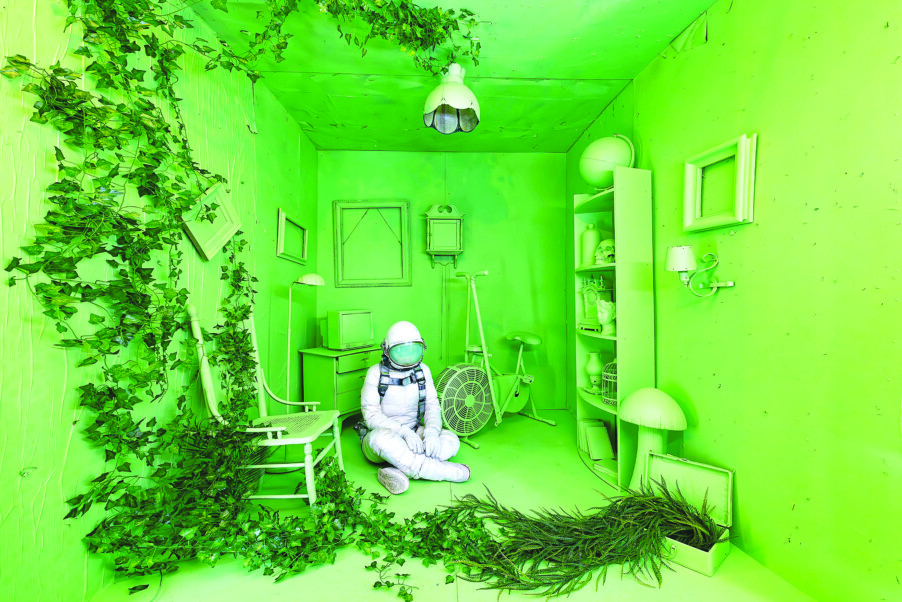The latest from NH’s theater, arts and literary communities
• Spring fair: The Craftworkers’ Guild in Bedford will open their spring fair on Thursday, May 2, at the Oliver Kendall House (3 Meetinghouse Road in Bedford, at the bottom of the library parking lot). The guild’s fair is open from 10 a.m. to 5 p.m. daily through Saturday, May 11. See thecraftworkersguild.org.
• Tribute, with laughs, to Broadway: Forbidden Broadway, a musical spoof of Broadway shows and stars, will come to Stockbridge Theatre (5 Pinkerton St., Derry; stockbridgetheatre.showare.com) on Thursday, May 2, at 7 p.m. A theatrical institution since 1982 when Gerard Alessandrini created the first edition, lampooning the Broadway shows and stars of the day, Forbidden Broadway in its newest edition includes good-natured shots at Moulin Rouge, the all-Yiddish Fiddler on the Roof, Hadestown, and this season’s dark Oklahoma! revival, along with Dear Evan Hansen, Tootsie, Beetlejuice, Frozen and a whole new generation of Broadway stars, plus some classic laughs from The Lion King, Phantom of the Opera, Les Miz and others, according to a press release. Tickets cost between $35 and $45. Call 437-5210 for tickets.
• Tale as old as time: Windham Actors Guild brings Disney’s Beauty and the Beast to the stage for audiences at Windham High School Auditorium (64 London Bridge Road in Windham) on Friday, May 3, at 7 p.m.; Saturday, May 4, at 7 p.m., and Sunday, May 5, at 2 p.m. This classic musical is brought to life by a talented cast of adults and youth, a live orchestra, beautiful settings, and costumes, according to a press release. Ticket prices are $22 for those 18 and older, $18 for students and seniors, and $15 for children under 12, according to the same release. Visit windhamactorsguild.com or call 247-8634.
• Fiddles! The New Hampshire Fiddle Ensemble begins a series of performances this Friday, May 3, in Rochester. This community orchestra made up of approximately 100 musicians of all ages and abilities plays a variety of acoustic instruments, according to their website. Performance dates include Friday, May 3, at 6:30 p.m. at the Rochester Opera House (31 Wakefield St. in Rochester); Saturday, May 11, at 6:30 p.m. at Interlakes High School Auditorium (1 Laker Lane in Meredith); Saturday, May 18, at 6:30 p.m. at Exeter Town Hall (9 Front St.) and Sunday, May 19, at 2 p.m. at the Derryfield School (2108 River Road in Manchester). The ensemble features fiddles, guitars, banjos, mandolins, basses, harps, cellos and more, according to a press release. See nhfiddleensemble.org for tickets.
• Classical meets folk: The Rex Theatre (23 Amherst St in Manchester; palacetheatre.or) will feature The Kruger Brothers on Saturday, May 4, at 7:30 p.m. Their remarkable discipline, creativity and their ability to infuse classical music into folk music has resulted in a unique sound that has made them a fixture within the world of acoustic music, according to the event’s website. Tickets range from $35 to $49. Gold Circle tickets include a meet-and-greet with the band after the show. Visit palacetheatre.org.
Art Stroll
This year’s May Gallery Stroll in New London includes two new locations, Whipple Hall and Grounds Coffee, making six locations during this First Friday Gallery Stroll’s artist’s reception scheduled for Friday, May 3, from 5 to 7 p.m. at each gallery location, according to a press release. This event is free and allows guests to meet local artists, enjoy art, and connect with the community, according to the release. Starting at Whipple Hall there will be an exhibit of Ruth Wynn’s work as a ‘memoriam’ of her talent; Grounds Coffee will host emerging artists such as Emily Philbrick of Artsy Em Designs, who strives to provoke emotion and transform spaces with her abstract work, landscape scenes and linework; teen artist Grace Scarlet will be featured at the Bar Harbor Bank; Blue Moon Bakery will showcase artists Debbie Campbell and Sherie Dowsett; The Tatewell Gallery will feature works by New York City native Tom Barber; the New London Inn will host artwork from Alison Vernon, who has been painting for over 40 years, and The Fleming Center Connolly Gallery at the New London Barn will host art by Timothy Sievers. Visit centerfortheartsnh.org/microgalleries.
• On stage, part 1: The Players’ Ring (105 Marcy St., Portsmouth) presents The Legend of Georgia McBride by Matthew López, directed by Joe Juknievich, from Friday, May 3, to Sunday, May 19, with shows on Fridays and Saturdays at 7:30 p.m. and Saturdays and Sundays at 2:30 p.m., according to their website. The show follows Casey, an Elvis impersonator who has everything until in a flash he loses his gig, his rent is overdue and his wife announces a baby on the way. So when Elvis leaves the building and a drag show moves in, “The King” transforms into an all-out queen with the help of some new friends who become the second family Casey never saw coming. Tickets are $31, $28 for students and seniors. Visit playersring.org or call 436-8123.
• On stage, part 2: Spring Awakening opens at the Seacoast Repertory Theatre (125 Bow St. in Portsmouth; seacoastrep.org, 433-4472) on Thursday, May 2, and runs through Sunday, May 26. Shows this weekend are at 7:30 p.m. on Thursday, 8 p.m. on Friday, May 3, and 2 and 8 p.m. on Saturday, May 4. Tickets cost $37 to 68, according to the website. The Rep is also continuing its run of Willy Wonka, which is on stage through Sunday, May 19. This weekend catch it on Sunday, May 5, at 2 and 7:30 p.m.
A truth Universally Acknowledged
The Community Players of Concord will presents Pride and Prejudice at Concord City Auditorium (2 Prince St. in Concord, 228-2793, theaudi.org) Friday, May 3, and Saturday, May 4, at 7:30 p.m., and Sunday, May 5, at 2 p.m. Adapted by Kate Hamill from the novel by Jane Austen, the Players describe the adaption as “fresh and funny, hip and hilarious” on their Facebook page, where you can see photos of the cast in costume. “This is not your usual Pride and Prejudice. There are a couple of balls, lovely costumes, but there’s also disco, modern music and Mr. Darcy’s shirt stays absolutely dry, ” according to the director’s notes as quoted in a Players’ Facebook post. Tickets cost $20 for adults, $18 for age 17 and under and seniors 65+. See communityplayersofconcord.org. At left, Travis Laughlin is Mr. Darcy, Julia Kehr is Elizabeth Bennet. Photo by Michael von Redlich.
• Makers market: Shop the Squam Lake Vintage & Makers Market at Cottage Place at Squam Lake (1132 Route 3 in Holderness; cottageplaceonsquam.com) on Saturday, May 4, and Sunday, May 5, from 9 a.m. to 4 p.m. each day. Admission is $5. The market will feature vendors, live music, food and a mobile bar, according to an email.
•ARTalk: Registration is open for an ARTalk with London-based artist Hew Locke on Sunday, May 19, at 2 p.m. at the Currier Museum of Art (150 Ash St. in Manchester; currier.org, 669-6144). The cost is $30 for adults, $25 for 65+ or students with ID, $15 for ages 13 to 17, $10 for museum members and free for children (the cost includes museum admission). Locke’s sculptural installation “Gravesend” is on display at the Currier and he has an exhibition, “The Procession” at the Institute of Contemporary Art Watershed in Boston on May 23, the website said.
Whose Town?
Take in a classic when the Nashua Theatre Guild presents Thornton Wilder’s Our Town on Friday, May 3, and Saturday, May 4, at 8 p.m. and Sunday, May 5, at 2 p.m. at the Court Street Theater (14 Court St. in Nashua). Our Town shares the idea that we live life without really appreciating what it has to offer, according to a press release. The Nashua Theatre Guild asks that if you dine in at the Margaritas in Nashua on Saturday, May 4, between noon and 11 p.m., you mention the Nashua Theatre Guild — if you do, 20 percent of your bill will be donated to NTG, according to the release. Tickets to the show are $20 for adults (18 and older), $18 for students and seniors. Visit nashuatheatreguild.org.



